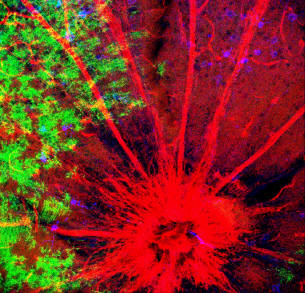Research
Research in our lab is focused on identifying genes and mechanisms that underlie embryonic and early postnatal development of the retina.

Two genes that are vital for normal development of the nervous system are Down syndrome cell adhesion molecule (Dscam), and its homologue Down syndrome cell adhesion molecule-like (DscamL1). Using mutant mouse models we have found that these genes facilitate spacing and organization of retinal neurons.
Research also utilizes genetically engineered mouse models that allow genes to be deleted in certain cell types or at certain points in development, as well as transgenic mice that express fluorescent markers in defined neural populations.
Currently we are trying to identify the mechanism by which immature neurons are integrated into functional neural circuits, and trying to identify what factors contribute to normal developmental cell death.
The optic disk (lower center) is the site where retinal ganglion cell axons leave the eye and project to their target brain nuclei. In the above image cells labeled green have had a gene required for normal development deleted, while red cells are wild type.
